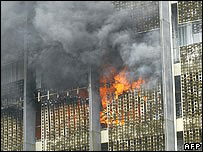 |
“4.4.4 Electrical fault in one of the following forms could be the cause of the fire:
4.4.4.1 Overheating of an electrical wire due to mechanical or poor connection. This high contact resistance overheating occurs within the capacity of the circuit breaker/electrical protection device. For the failure to occur, the wire should be in the close proximity of combustible material such as timber or bituminous sound proofing material in the ceiling.
4.4.4.2 Failure of the cables serving the fluorescent
light. Such a failure may occur after mechanical damage
to the cable or due to a possible manufacturing defect
of damage to one of its internal cables.
4.4.4.3 Splinting of electrical conductors/cables. Electrical
over current and mechanical breakage of wires or overheating
can result from this practice.
5.1 The exhibits were collected by Investigators from Liberian Government for laboratory examinations and were handed over to Director Gouws of the South Africa Police Service Forensic Science Laboratory (Analysis request letter is filed herewith).
5.2 Exhibits were kept under exclusive control of Chief Forensic Analyst TL Mulaudzi by keeping them under lock and key from 2006-08-05 to 2006-08-11, when they were handed per hand to Assistant Forensic Analyst MJP Mongane for analysis.
5.3 According to Assistant Forensic Analyst MJP Mongane:
5.3.1 No traces of ignitable liquids were detected in the exhibit material (Analysis results are herein attached).
5.4 Exhibit marked “Sample 3” was examined by myself and signs of electrical fault were observed on the wires (Photographs 102 to 104). Derived from the analysis requested letter, this exhibit was in the vicinity of the fire origin (copy attached).
It is my opinion with the information at my disposal at this time that:
6.1 the fire started in the Cabinet room (in the roof void);
6.2 arson can be excluded as the cause of the fire as there were no indications to that effect; and
6.3 electricity is the most probable cause of the fire.”
© 2006 by The Perspective
E-mail: editor@theperspective.org
To Submit article for publication, go to the following URL: http://www.theperspective.org/submittingarticles.html
